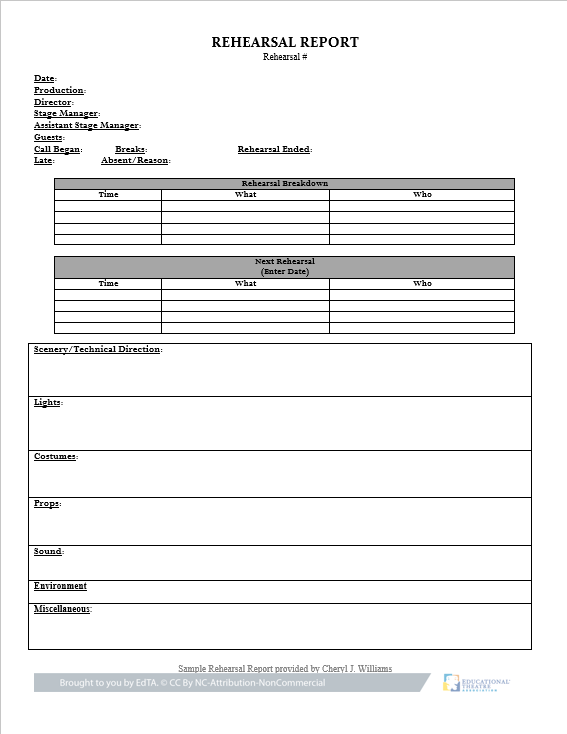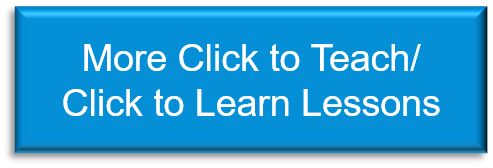
Click to Teach/Click to Learn: Stage Management
Ever wonder what a stage manager does? The American Association of Community Theatre explains a stage manager's role as follows:
"Stage managers typically provide practical and organizational support to the director, actors, designers, stage crew and technicians throughout the production process. They also are the director's representative during performances, making sure that the production runs smoothly."
But what does that mean in practice? You'll find out in this lesson!
This unit is based on a TE-Pro webinar by Equity Stage Manager Cheryl J. Williams, Developing Student Stage Managers.
Step 1: Get Inspired
Watch the following video to learn about the role of a stage manager for the Broadway production of Wicked.
- What does the production stage manager say is the most important thing that she does?
- Why is it crucial to have the stage manager call a lighting cue?
- What are the things that the video mentioned that are included in the nightly performance report?
- How does this video illustrate the ways in which the stage manager makes the production run smoothly?
Step 2: Learn about Stage Management
Quick Introduction
Watch the following video for a quick introduction to a Stage Manger's Prompt Book, which is a crucial tool for the stage manager's job. The Prompt Book is created by the stage manager over the course of the entire rehearsal process, and it documents everything about the production.
The creator of this video covers a wide variety of items that a stage manager will usually include in their prompt book. For this assignment, you will only be focusing on the following:
- Environmental needs of the scene (props, set, lights, and sound) at different moments
- Cues, or when those environmental needs will change within the scene
- Rehearsal reports
Diving Deeper: Stage Managers In Action
Choose one or more of the following articles from Dramatics.org to better understand the role of a stage manager.
- SM Guide to First Rehearsal Prep
- How Stage Managers Facilitate Effective Rehearsals
- Stage Manager’s Role in Tech
- SM Guide to Executing Tech Rehearsal
- SM Role in Performance
Having explored a stage manager's role, what do you think might be the most important qualities of a good stage manager?
Step 3: Record Environmental Needs of the Scene
The stage manager's first job when working on a show is to read the script. For this assignment, we will use the four minute play, THE PETZY/SPATHA, written by Jon Jory. Download and print a copy here.
Download and print out your script, or load it into a Google Doc or other space where you can add notes and comments. As you read the script, take notes to indicate the following:
- Who is on stage? When do they move?
- What are the environmental needs (props, lights, sounds) throughout the scene? When do they change?
These notes on the environmental needs throughout the scene will provide the basis for your cue sheet in the next step.
Step 4: Create a Cue Sheet
In the video in Step 1, the Wicked stage manager explains how the main stage manager "calls the show". The Wicked lighting designer goes on to explain that "the reason that the stage manger calls what we call a light cue... is so that she's able to coordinate it with scenery, prop movement, actor movement, the score, the conductor, and lights, so all these things happen together..."
In order for the stage manager to be able to call a show, they must first create all of the cues for themselves. The creator of the video in Step 3 discusses the "Post-it flag method" for writing in cues. In the video below, the stage manager shares his method for writing cues directly on the script. Both methods are acceptable, it just comes down to the preference of the stage manager. As you start to write cues for this assignment, you are welcome to try both of these methods, or choose just one.
Watch a clip from the following video by starting at minute 4:38 and watching until minute 6:50. Pay attention to the following:
- How does he decide where a cue should be written?
- What tricks does he use to easily move cues?
- Who else does he work with to decide where cues should be placed?
For this assignment, you will create a cue list directly on your script. Either print out the script and write the cues next to the text, or upload the script into a Google Doc or other digital space where you can add notes and comments next to the text.
As the stage manager in the video explained, stage manager's shouldn't take a passive role in cue creation. While the designer and director have the final say in things like when the lights change, it is helpful for the stage manager to make a first attempt at deciding where cues will go, and let the designer and director give feedback. It is the designer's job to decide when a cue needs to be called in order to achieve the effect that the designer and director are envisioning.
View a sample Cue Sheet here, or look at the image below. As you write your cues into your script and create your cue sheet, make sure there is a very specific trigger for your cue. What is the exact spot in the text or blocking in which you will begin to call your cue?

Step 5: Call the Show with your Cue Sheet
Get out the cue sheet you created in the last step, you will be using it to "call the show" by viewing this brief video taped rehearsal as if it were an actual rehearsal of a live show. Play the video and call out your cues as if the actors, light and sound crews and backstage crew were hearing your direction. Go back to Step 2 and re-watch part of the video if you need a reminder of how a stage manager calls cues out loud.
If this is for a homework assignment, you can also record yourself using a cell phone as you call the show, and turn in the recording as a part of your work.
NOTE: Recording of "Petzl Spatha" by Jon Jory shared for educational purposes with permission.
Step 6: Complete a Rehearsal Report
Now that you've stage managed a rehearsal, you need to complete a rehearsal report.
Rehearsal Reports are completed by stage managers after every rehearsal, and they detail what happened during the rehearsal including start and stop times, any changes, any missing items or cast needs, and any important information shared during that rehearsal. One reason stage managers create rehearsal reports is to communicate and record a summary of the rehearsal for anyone on the production team that wasn't in attendance. The rehearsal report is both a record of the process and an important communication tool so that the whole team knows how the production is coming along.
Download the rehearsal report template here, and complete it for your rehearsal. Be sure to include:
- How was the rehearsal? Did anything go wrong?
- Who was present at the rehearsal?
- What did you rehearse?
- How long did it take? What was the start time and end time of the run?
- Was there anything missing? (ex. props)
- Any important notes for the designers?
You may need to use your imagination a bit, but be sure to include all of the information above.

Measuring Learning
Classroom Connections
This unit may be modified for teaching for Middle Grades, HS Proficient or HS Accomplished. Some suggested standards are below:
Middle Grades
TH:Cr2.1.8.b. Share leadership and responsibilities to develop collaborative goals when preparing or devising drama/theatre work.
TH:Cr3.1.8.c. Implement and refine a planned technical design using simple technology during the rehearsal process for devised or scripted drama/theatre work.
HS Proficient
TH:Cr2.1.HSI.b. Investigate the collaborative nature of the actor, director, playwrite, and designers and explore their interdependent roles in a drama/theatre work.
TH:Pr6.1.HSI.a. Perform a scripted drama/theatre work for a specific audience.
HS Accomplished
TH:Cr2.1.HSII.b. Cooperate as a creative team to make interpretive choices for a drama/theatre work.
TH:Pr6.1.HSII.a. Present a drama/theatre work using creative processes that shape the production for a specific audience.
| Access Date | Quiz Result | Score | Actions |
|---|
Learning Center
- Webinars
- Adjudication Trainings
- Featured Courses
- Full Course List
- Lesson Plan Library
- Click to Teach Interactive Online Lessons
- Resources for New Theatre Teachers
- Technical Theatre Educator's Manual
- Connected Arts Networks
- Diverse Resources for Theatre Education
- Behind the Scenes Technical Theatre Curriculum
- Social & Emotional Learning
- Additional Standards Based Instructional Resources
- Search the Catalog
- Cart (0 items)
Full Site Search
Membership Benefits
Join EdTA for full access to our professional development and standards-based teaching resources, including:
- 300+ lesson plans
- Click to Teach online lessons
- K-12 curriculum
- Webinars
- And more!




